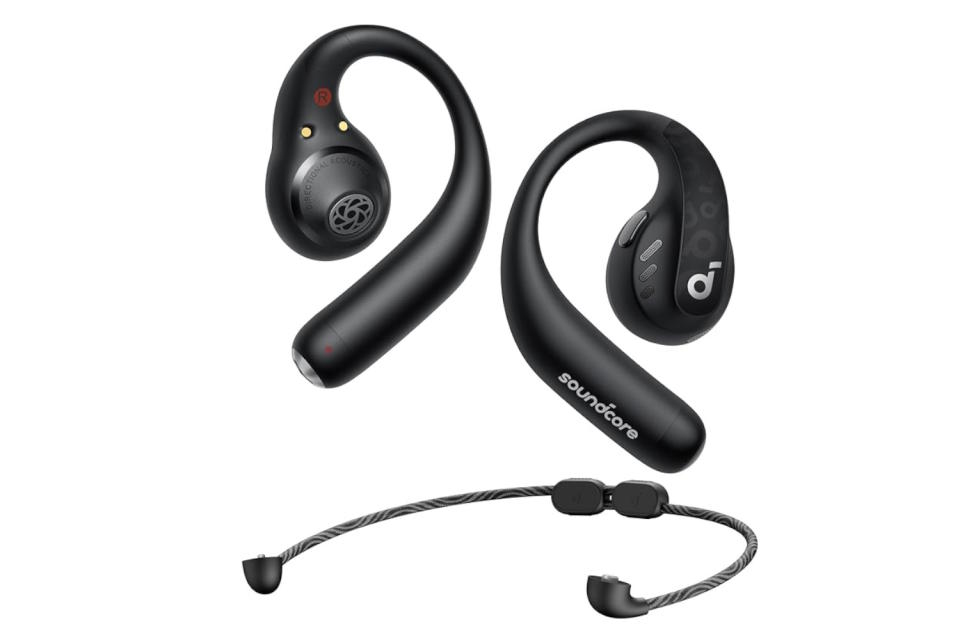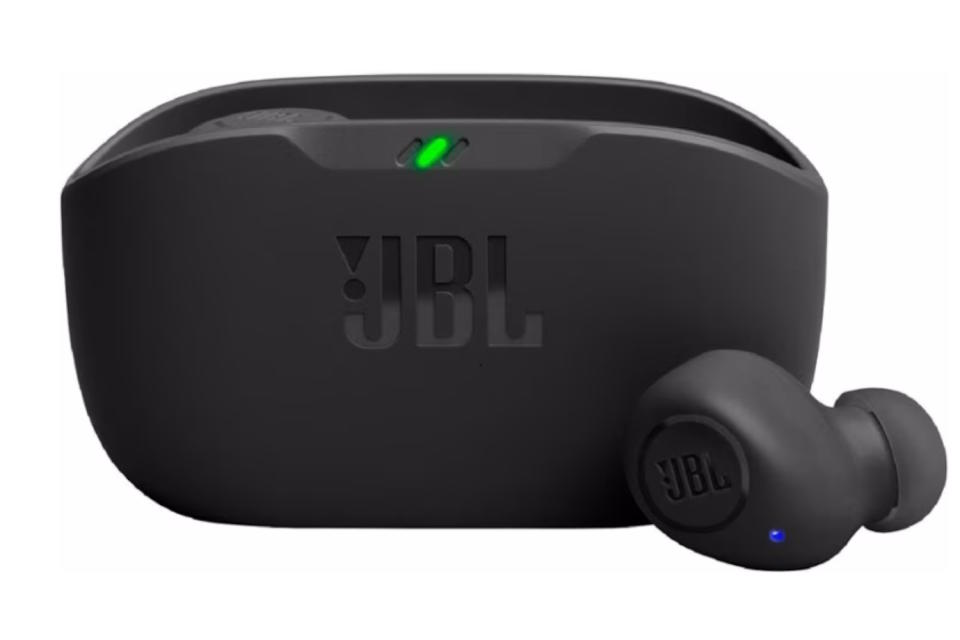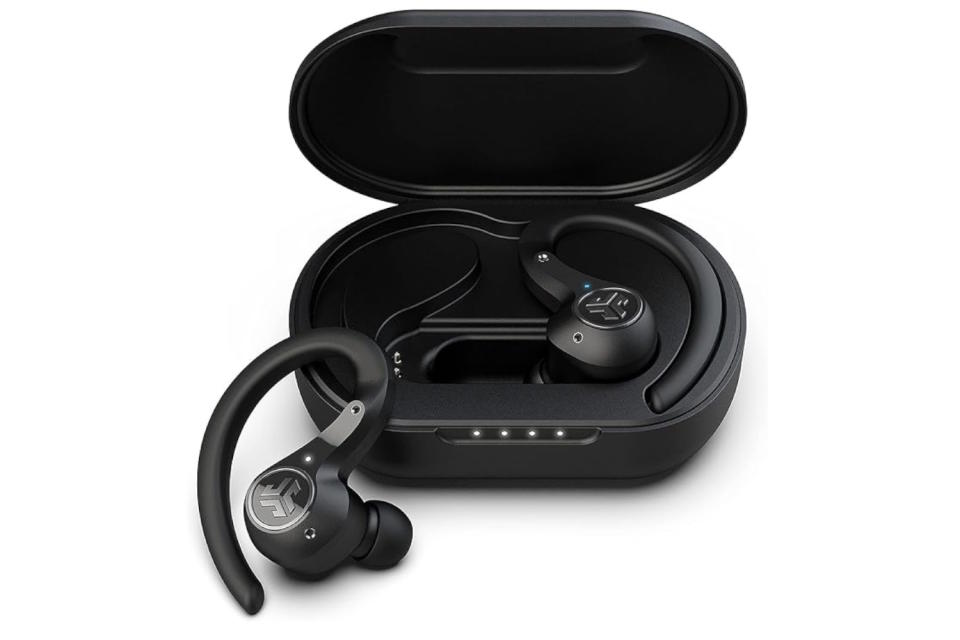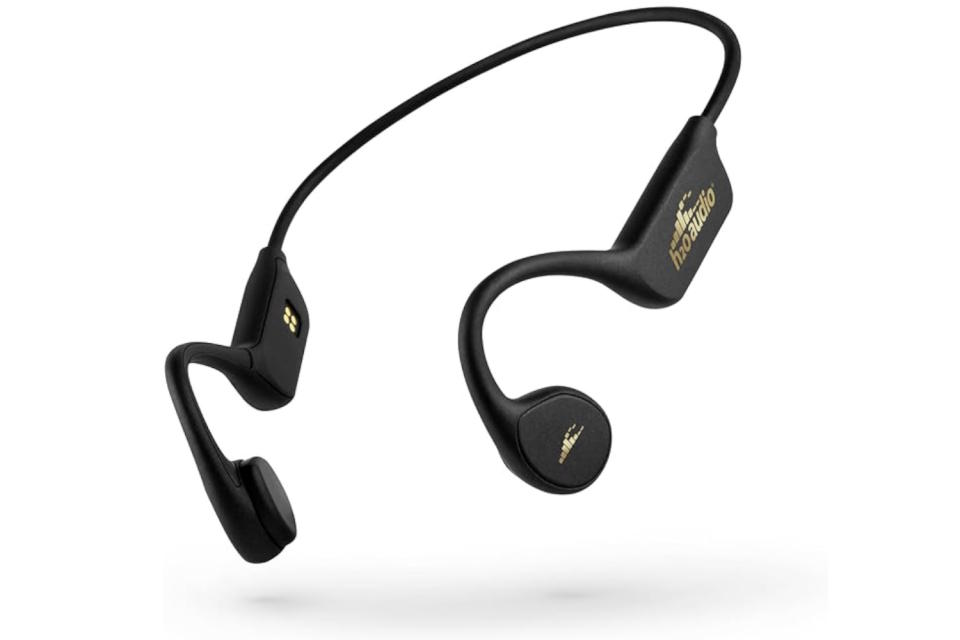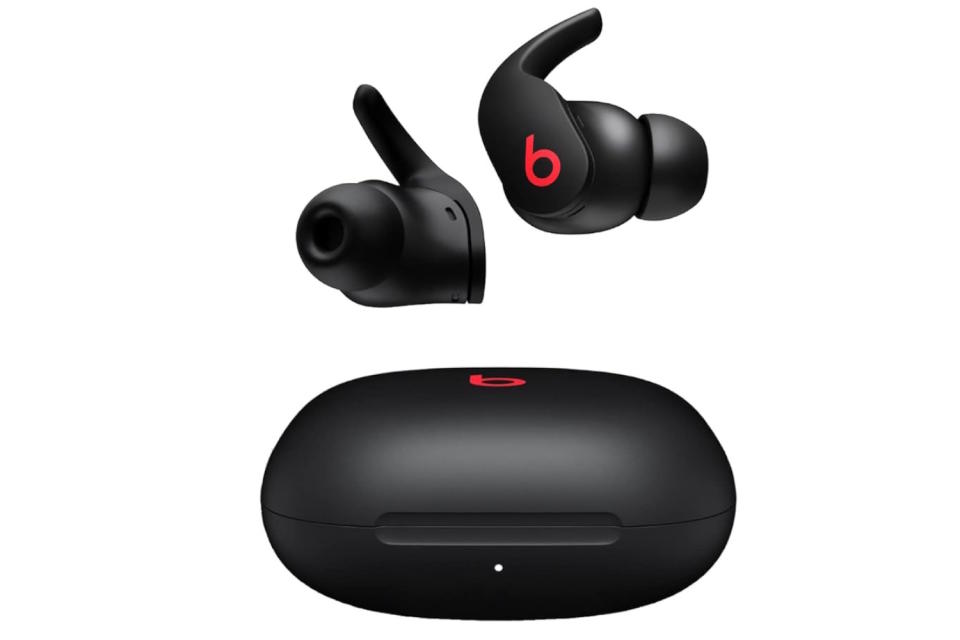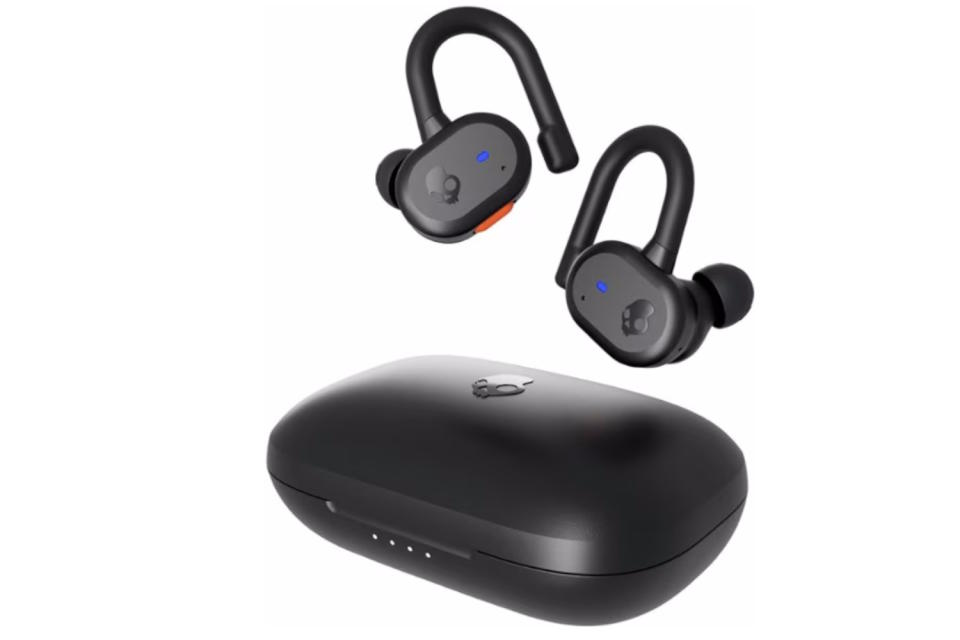The Best Running Headphones of 2024
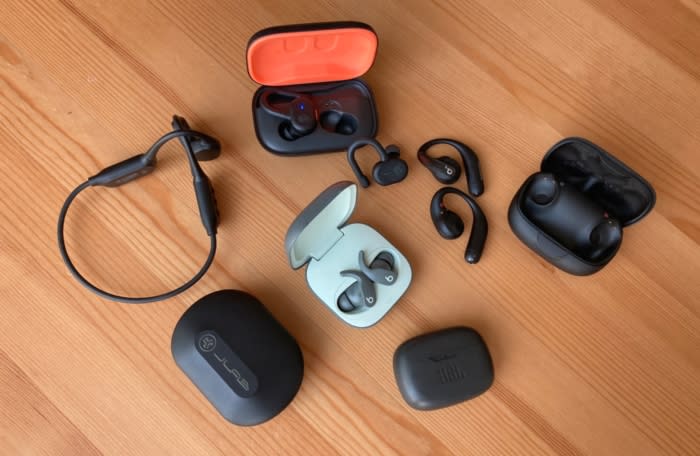
Buying the best running headphones can be a dice roll. Virtually all of us use them, but these techy tidbits come in all over the board. Depending on what you’re doing, they can miss the mark. The best running headphones provide strong field performance like fit and durability. Condition-specific factors — touch functionality, water resistance, and connectivity — could make or break anyone’s hype on a run.
How can you be sure whether the headphones you’re thinking about will stay put if you take a spill, go parkour, or run during an earthquake? And if you’re going the distance on a triathlon or ultramarathon, will your headphones’ batteries survive?
Of course, the best headphones for running bring the noise no matter what mile you’re on. And here, our runners covered the distance to bring you our favorite picks.
GearJunkie’s testers have cut trails and pounded pavement since the days when wearable heart measurement technology was novel. To find the best running headphones of 2024, we tested buds on choppy trails in Texas and crowded city streets in southeast Asia. With dozens of earbud tests under our belts, we identified six of the best running headphones for this best-of list.
Best Overall Running Headphones: Soundcore Aerofit Pro
Best Budget Running Headphones: JBL Vibe Beam
Best-Fitting Running Headphones: JLab Epic Air Sport
Best Waterproof Running Headphones: H2O Audio Tri Pro
Best Sounding Running Headphones: Beats Fit Pro
Best Mid-Range Running Headphones: Skullcandy Push Active
Best Overall Running Headphones
Soundcore AeroFit Pro
Specs
Battery Life 14 hours (tested), 46 with case (claimed)
Weight 95.5 grams (with recommended neckband)
Water Resistance IPX5
Features Detachable neckband, Customizable EQ or spatial audio
Pros
No pressure points
Good balance between earphone sound and ambient sound
Comfortable adjustable neckband design
Long battery life
Cons
Loose fit without neckband
Soundcore has created a headset that, in our opinion, barely misses a mark for a runner poised to go the distance. The Soundcore AeroFit Pro ($170) is packable, lasts forever, supports awareness and comfort, and sounds balanced and just loud enough.
First of all, our testers could not outrun the AeroFit Pro. Unable to go for 14 straight hours, we had to run in the morning, link the Soundcore buds to a spare computer, and let them play. Unlike some other buds that claim varying battery life depending on mode, there’s no active noise cancellation (ANC) or other settings to mess with on the AeroFit Pro — 14 hours is 14 hours.
Even though we couldn’t waste an AeroFit battery on a single run, we are confident a runner could wear them comfortably for any amount of time. Admittedly, we were initially worried that the fit would be too loose. The open-ear construction and generous fob on the tail did cradle the ear but by no means gripped it. One tester had never felt a looser earbud that was not a handout on an international flight — but the adjustable neckband solved any security issues.
The color-coordinated kit came together with an easy metallic snap and cinched down over the back of the neck. Each earbud suddenly felt secure, though far from tight. The coarse material never abraded our testers’ skin, and the set came apart easily to stash in a pocket during stops.
In motion, our testers first noticed the balance of earphone and ambient sound. Some open-ear units let in enough noise to be distracting but throw screechy or tinny audio. Instead, thick, fully-shaped sound poured from the AeroFit Pro’s robust 14mm drivers. And enough of the surroundings leaked in to keep our testers aware but not irritated on trails and city sidewalks.
Custom sound settings soon gave way to a preference for spatial audio (see Beats Fit Pro). We wish one didn’t have to replace the other, but it wasn’t the only shortfall of the Soundcore earbuds.
Button control was reliable but rudimentary. Each earbud button only supports two commands. While that’s almost all most runners need, app support for a more detailed switchboard and/or voice control would make sense.
Still, we expect long-distance runners will have difficulty leaving the Soundcore AeroFit Pro at home. The set earned our respect as a machine built well for a specific purpose. Runners won’t find shock-and-awe sound or state-of-the-art app function here. But they will get great battery life, a blend of solid sound, and high-standard comfort that no other headphones we tested can match.
$170 at Amazoncheck price at soundcore
Best Budget Running Headphones
JBL Vibe Beam
Specs
Battery Life 8 hours (tested), 32 with case (tested)
Weight 48.4 grams
Water Resistance IP54
Features JBL Headphones app compatibility
Pros
Durability
Water resistance
Very carryable, tightly-built case
Long-term reliability
Cons
Can jostle loose
Easy to activate touch controls while adjusting the fit
JBL’s Vibe Beam ($45) endured a multiyear test as our tester’s all-around, everyday headphones. Especially at the price, they performed extremely well. Battery life, sound quality, portability, and durability — they once survived a long wash cycle — were all highlights.
The first satisfactory point is the case construction. The tensioning lid closure snapped shut tight and left very little seam. The hinge was smooth and consistent, and the weight inspired confidence — especially for such a small case. During testing, the earbuds could feel like just another everyday carry item. The case wasn’t substantially bigger than most modern car key fobs, so packing it was often a no-brainer.
The JBLs paired with no issue, and our tester immediately liked the sound quality and overall comfort.
With no retaining hook or other fiddly bits, sizing the ear tips was the only factor in a simplistic fit. The buds never struggled to pair or hold a connection during testing on trails, busy streets, or travel. The speakers also stayed consistent over the entire testing period. They resisted damage from the washing machine episode, random loose pocket carry, cleanings, and numerous drops.
But despite surviving it all, those last two stressors indicate the main reasons the JBL Vibe Beam didn’t test as a perfect earbud for runners. Our tester’s fit was never tight enough to retain without adjustment during intense or jostling activity. Especially on longer runs, our runner reported a lot of “Secret Service” syndrome — compulsively touching the earpiece, in this case, to re-secure it.
On one sweaty road bike ride, an earbud actually squelched free from our tester’s ear without warning. He found it with a touch of grime on it and cleaned it with a squirt of water. Q-tip cleanings were relatively frequent no matter what — repeatedly twisting the tips into ear canals caused them to pick up any and all waxy bits.
Overall, the JBL Vibe Beam scanned as an inexpensive earbud with great battery life and all-around solid performance. A casual runner with a wide range of earbud needs could do much worse.
Best-Fitting Running Headphones
JLab Epic Air Sport
Specs
Battery Life 15 hours (claimed), 50+ with case (claimed)
Weight 96.3 grams
Water Resistance IP66
Features 3-setting ANC, Integrated charging cable, Customizable touch control
Pros
Secure over-ear fit
Loud
Good voice call function
Cons
The case takes up lots of room
Little difference between ANC/non-ANC
With a modest price point, huge claims, and five-star reviews all over the internet, the JLab Epic Air Sport ($100) was begging for a test. We wanted to see what the hype was about, so we put it through the ringer.
Our tester found a confidence-inspiring fit, satisfying volume, easy-to-touch controls, and reliable voice calling. The earbuds felt totally comfortable on runs up to 2 hours long and never induced stress about function.
Our test revealed fit and volume worked together in the JLabs to create overall utility. For our tester, it’s important to minimize distractions because it’s easy to overthink on a run. The JLabs strongly provided this effect. During testing, the fit never became an issue, and the sound — while not the highest quality — capably drowned out everything outside our tester’s skull, including city traffic.
This produced easy confidence on runs across distances and locations. We defy most everyday athletes to find a better experience at the price. But the Epic Air Sport did suffer from some shortfalls.
While our tester didn’t find quality concerns with the JLabs, a performance gulf still exists between them and leaders like Beats by Dre. The speakers were loud, but thumpy bass and tweety treble washed out at the higher end of the volume scale. That was true right out of the case, and we are curious how they will perform long-term.
Also, even though they boast three ANC levels (on, off, and “be aware”) that are easy to toggle between, testing didn’t indicate much difference between them. Testing on a footbridge under one of the busiest urban expressways in Austin, Texas showed the shortcomings. No matter which setting our tester selected, he could only perceive his sonic surroundings if he consciously tried to.
Next, the case form factor is significant. Though roughly common for headphones with ear hooks, it’s fairly heavy. The only way the carry would be negligible is with a hydration pack or vest — some long-run accessory that afforded extra pocket space.
Finally, the integrated charging cable did not sell us. Sure, these are convenient — until they die, get crushed or cut, damaged in a drop, etc. We also noted the choice to use a USB out, which seemed questionable as the world approaches a USB-C standard.
Despite some flaws, our tester loved how easy it was to pump tunes and get lost in the secure-fitting JLab Epic Air Sport. At a low price point and high utility, it’s an earbud for the running masses — even if it overlooks some details.
$73 at Amazoncheck price at jlab
Best Waterproof Running Headphones
H2O Audio Tri Pro
Specs
Battery Life 4.5 hours (tested)
Weight 33.5 grams
Water Resistance IPX8
Features On-board playlist function, Swim-friendly
Pros
Very easy to hear surrounding noise
Tight waterproofing
Listening doesn’t require paired device
High voice call quality
Cons
Quiet sound except underwater
Short battery life
Proprietary charging port
H2O plunges deep into the waterproof headphone game with the H2O Audio Tri Pro ($180), a bone conduction set that can survive “unlimited” submersion down to 12 feet. At IPX8, nobody on the market sells a headset that’s tougher against water.
This capability helps the “tri” (as in triathlete) branding hit right on target. We tested the Tri Pro through several cool-down swims and showers, enough to build confidence that they wouldn’t punk out over the course of a prolonged swim.
Right out of the box, we liked the neckband’s springy feel, seams that looked plenty tight, and the simplistic three-button control. The Tri Pro also withstood some punishment in the long run, springing back into shape after our tester jammed it into tight-packed carry-ons and stuffed it in backpacks under piles of other gear.
The bone conduction action created a massaging thrum against the temples our tester found pleasing and facilitated easy awareness of surrounding hubbub. However, our anecdotal experience with bone conduction sets immediately made us skeptical about sound quality. Overall, our tester didn’t think the Tri Pro stood out from the pack.
Sound above the water surface was predictably washed out and tinny. Our tester also consistently wished he could increase the volume — but this ain’t Spinal Tap, and there is no 11. Applying the supplied earplugs did increase the perception of volume, but made everything seem more muffled. It sounded pretty similar to the underwater effect. Our tester also advised that it felt awkward and defeated the open-ear benefits.
Other features proved similarly hit-and-miss. It’s cool that you can leave your watch or phone behind by loading a playlist into the headphones themselves, but we found the setup somewhat frustrating. The Tri Pro charged fast, but a short battery life kept our tester modest on distance, and the proprietary charging cord introduced a loss-or-damage hazard — especially during travel.
Overall, avid swimmers or snorkelers might very well love the H2O Audio Tri Pro. We could see functionality for competition, too, where keen wherewithal in the pack can make or break a race, and fiddling with another device is out of the question.
Best Sounding Running Headphones
Beats Fit Pro
Specs
Battery Life 6 hours (tested), 24 with case (claimed)
Weight 66.1 grams
Water Resistance IPX4
Features In-ear wingtips, ANC Siri compatibility, Biomapped EQ, Find My
Pros
Extremely high sound quality
Tight fit, in-ear profile
Easy touch control
Very strong ANC, very penetrable non-ANC
Cons
Moderately low battery life
Loose case construction
There’s no other way for us to lead this review: this earbud’s tester has never listened to a better pair of headphones than these. But that doesn’t mean we’ll give the Beats Fit Pro ($200) a full five stars.
Beats Fit Pro checked our boxes in basically every functional category and knocked our tester out in sound quality and user experience. We have not experienced a stronger inclusion of active noise canceling and ambient sound modes in one set of buds. The satisfying, tactile button-click switch function made a lot of sense for anyone, especially runners with limited bandwidth for touch pressure or other nuance.
Setup was easy, and despite needing a quick charge before we could use them, they were user-friendly. Our tester stopped caring about that minor inconvenience when he cued up the noise.
On a satisfyingly high-tech note, the Beats prompt ear canal mapping when pairing them with an iPhone. It’s hard to tell whether it does anything, but it was fun, easy to do, and felt like a concierge service. (You can also bypass it if you’re suspicious of psyops by Apple bioengineers, or just don’t care.)
Bass was, in a word, rowdy. Our tester’s set of personal $250 MSRP JBL over-ear Bluetooth headphones fail to make nasty rap tracks or crunchy garage bangers hit any better. He was also relatively sure he could identify what Beats and others call “spatial audio” — a loadout of tech that uses accelerometers and gyroscopes to predict the movement of your head and make you feel like you’re “inside” the sound, rather than receiving it from a certain direction.
After about an hour of consistent wear, the Beats Fit Pro eventually created some ear discomfort. The Beats aren’t exactly light-duty hardware and come with only one size of rubber grommets. Also, the rubber tails that hold pressure against the curvy, swoopy part of your inner earlobe (which is called a concha ridge, it turns out) felt very springy. However, our tester found the ergonomics forgiving enough that he could flip the rubber tail outside the concha ridge and tread on most terrain just fine.
We wish we were sold on the battery life and, most of all, the case quality. Six hours will not keep every distance fiend out there jamming. And while the case is barely bigger than a Tic-Tac box and slipped into a pocket of basically any size, testing damaged our confidence that the lid would survive many shenanigans. We’ve felt tighter hinges on Lego sets — which is a shame because we liked its form factor and loved the strong magnetic snap the Beats Fit Pro made when we placed them back in the charging wells.
If you’re a short- or middle-distance runner who wants a reliable pair of headphones that sound not only great but also delicious, have strong ANC and ambient sound function, and stay put, then it looks like it’s Dre day for you, friend.
Best Mid-Range Running Headphones
Skullcandy Push Active
Specs
Battery Life 10 hours (claimed), 44 with case (claimed)
Weight 93.5 grams
Water Resistance IP55
Features Voice control, Find My, Customizable EQ
Pros
Easy to dial in fit
Loud
Easy voice commands
Fun app functions
Cons
Bluetooth wasn’t perfect during test
Stay Aware function sounded windy
Our tester was happily surprised by the Skullcandy Push Active ($80), which initially seemed pedestrian but later won him over with a combo of intuitive controls, easy fit, and a brutal icky thump.
The Skullcandies seemed builder-grade in some ways, with basic shapes in the design and a loud color array. But across weather conditions and longer outings, our tester found that they refused to budge from his ear canals, brought the noise when he wanted them to, and listened to his voice commands effectively.
The Push Active became a go-to for general running. Our tester might not reach for it in super wet weather or other compromising conditions, but for general after-work burns or sunny days, he eventually craved its strong, easy function.
We found the fit was especially easy. Once our tester had the right size tips, the U-shaped ear hooks pivoted easily over the ears in a single rotation. Instead of contorting the wrist to move a tapered hook into position, all it took was to jam an earbud in and twist backward. A gentle twist farther backward added tension — and worked as a sound amplifier.
Push Active headphones are not technically ANC. They have a “stay-aware” mode, but our tester found he wanted to avoid it. Wind noise was more distracting than helpful, so pure, noisy, ear-melting fun became the leading utility.
Help came from the Skullcandy IQ app, with a custom equalizer that probably wouldn’t do much for a sound engineer but did plenty for our tester. The sliders (controlling five pitch levels from “low” to “high”) didn’t offer the most nuanced control, but they helped tune music quickly and satisfyingly. Want more bass? Just crank “low.” It was that simple, and our tester liked it.
The voice control was another user-friendly touch. After linking the earbuds to the app, carrying the instructions in a pocket on one first run was enough to smooth the learning curve. The commands were straightforward and useful, so by the end of an hour or so, our tester had it down.
A final concern included Bluetooth connectivity, which tended to drop for a fraction of a second once or twice per run, no matter the location. (No other tested headphones showed this issue.) But in all, the Skullcandy Push Active scored highly for straight-ahead practicality. Emphatic sound, easy controls, and a tight fit — athletes at our pay grade can do much worse at the price point.
Running Headphone Comparison Chart
Running Headphones | Price | Type | Battery Life | Weight (with case) | ANC |
|---|---|---|---|---|---|
|
| 6 hours, 24 with case |
| Yes | |
$45 |
|
|
|
| |
$100 |
|
|
| Yes | |
|
|
|
|
| |
|
|
|
|
| |
$170 | Open-ear | 10 hours, 44 with case | 95.5 grams (with recommended neckband) | No |
How We Tested Running Headphones
GearJunkie’s runners have tested hundreds of men’s and women’s products on trails, in busy urban centers, and during competitive Adventure Racing. 2024’s running headphones tests built on that theme, with our testers ranging from Texas trails to central California, Singapore, and Thailand.
Performance demanded resilience under extreme heat (up to 95 degrees at 80% humidity on the Singapore streets) and during travel. City traffic, sweaty ears, and logistics of battery life and case carrying were constant factors. Testers put water resistance to the test in events including a brisk cool-down swim.
Testing periods ranged from months to years. We decharged and recharged headphones frequently and retested units to find our favorite applications for each product. Testers used their assigned headphones during recreational runs but considered possible uses during competitions within rule allowances.
The testers for this article have combined experience of over 20 years in middle-distance trail running, competitive track racing, and multi-sport activities like CrossFit. Our editorial team includes GearJunkie Adventure Racing team members, and editors for iRunFar.com provided product consultation.
We’re also real people, so we use headphones just like everyone else — running errands, attending meetings, and taking phone calls. We worked out, traveled, and vibed out to music in our running headphones. One improvised water resistance test took place when we forgot a pair of earbuds in a shorts pocket and threw the shorts in the washing machine.
Buyer’s Guide: How to Choose Running Headphones
Fit/Comfort
Even if you only go on short, half-hour jogs, the wrong-fitting headphones can still give you an earache. That said, it’s not always as simple as picking the set of rubber tips that feel the best and popping the headphones in. Pain from earbuds can come from the tips, over-ear or concha ridge hooks, or even constant re-adjustment.
Look for springy but flexible ear hooks like the ones on the JLAB Epic Air Sport, or a bone conduction set like the H20 Audio Tri Pro. For most, Apple AirPods can be a good choice — but because there’s no fit adjustment, there’s some possibility you’ll find yourself constantly fiddling with them to keep them snug.
Battery Life
Not every runner needs best-in-class headphone battery life, like the JLab Epic Air Sport provides. To be honest, most of us can’t run for 10 or more hours straight, no matter if we want to or not. But it’s always best to consider how else you’ll use your headphones outside workouts and what it takes to recharge them if the worst happens.
If you’re a daily commuter with an office job and an after-work running routine, consider headphones with long battery life on a single charge. It’s possible you’ll want more than 4 to 6 hours of listening time per day, and it’s easiest not to recharge unless you have to.
If you’re a marathoner, we’d encourage the same thing — start your run or race with a full charge and save precious grams by leaving the case behind.
If you’re a hardcore adventure runner who can do 30, 50, or 100+ miles, look for quick recharge time and a well-built, compact case. You might not hit 0% on your run, but your headphones likely will.
Touch/Voice Controls
The key to success in headphone touch controls for runners: simplicity.
Most of us don’t want to think about anything while we’re running. Others get their best thinking done while they’re knocking out miles. The common denominator is that the last thing any of us want to think about is how many taps it takes on which ear to activate what function.
“OK, so do I tap my left earbud three times for the last track, twice slowly then once quickly to activate voice control, and one-touch followed by two clicks to toggle ANC? Or is it only once slowly then twice …”
Nobody wants that. Our staff also prefers button or voice control over touch control. It may be common for runners to scratch itches, wipe sweat from their faces, etc. Pawing a touch-activated earbud repeatedly can lead to functional frustration. We got along well with the Skullcandy Push Active voice assistant and button controls.
Noise Canceling or Non-Noise Canceling
Active noise canceling (ANC) headphones have skyrocketed in popularity as the technology has improved in smaller and smaller packages. ANC uses one or more microphones to collect, measure, and “cancel” incoming sound by producing counteracting sound waves.
So, do you need ANC in running headphones? Safety-conscious, urban runners or those who just like listening to the birds and the bees may resist it. As our testing revealed, some of today’s ANC is extremely potent, making it impossible to hear normal noises anywhere nearby. It can be intimidating.
However, audiophiles or runners who prefer to zone out can revel in the sonic focus ANC provides. To jam out on music and let the vibes take over (testing or otherwise), our testers reach for the loudest pair of ANC headphones. The technology pairs especially well with the surge in custom equalizer tools for headphones . And if you’re ably sighted, you can always keep your head on a swivel to keep yourself safe.
In-Ear or Open-Ear
Each of these categories carries one main drawback and one main advantage. Headphones with in-ear designs sound louder but can become painful after hours of wear. Open-ear designs are more comfortable, but never bring the same thump as in-ear buds.
Runners can consider mileage to help call a shot. Do you really want anything in your ears for 10, 24, or 30+ hours? Not all in-ear buds are created equal, it’s true — and the better the fit, the less earache you’ll face. But the advantage of open-ear buds over extended wear periods is that there’s actually a possibility you’ll forget you’re wearing them. Not only that, but you’ll also stay more directly tuned to the outside world. The Soundcore Aerofit Pro showed very balanced open-ear sound quality during our tests.
On the other hand, the whole reason you run might be that you like getting lost in your own world. In that case, an in-ear set can better defend your groove from the ingress of external hassles we all navigate.
Water Resistance/Ingress Protection
The IP system strikes again! Remember, look at the last two digits (either an X and a number or two numbers). The first digit stands for dust and debris resistance, the second is water. The common IP54 means that it can let in some dust but not enough to hurt the device (5), and that it’s protected from splashing water (4).
Anything beyond this, and you’ve got a pretty robust earbud for running. IPX5 is water jet-protected, and IPX6 gear won’t yield to “powerful water jets” or “heavy seas.”
Yo ho, yo ho.
FAQ
Which headphones don’t fall out while running?
Headphones with rubber or silicone hooks that loop over the top of the ear are likely to inspire the most confident fit in the category. But that doesn’t mean other types will just fall out willy-nilly.
Beats Fit Pro’s “wingtips” provided a tight fit in our testing. The tips hold pressure against the inner ear ridge which, while not super comfortable over time, was unquestionably secure.
In open-ear sets, neckbands not only help keep a set together if you take a tumble, but also add positional stability. The H2O Audio Tri Pro even includes a rubber leash you can attach to your glasses or goggles during races or swimming.
Is it safe to wear headphones while running?
Running safety questions virtually always have situational answers. (Is it safe to run without water? If you’re in a busy city, sure — if you’re in the Moroccan desert, not so much. And so on.) This is one of those questions.
Depending on your running conditions, you could need a pretty disparate kit to keep yourself safe. Let’s say you’re in the suburbs, running on straight-line sidewalks that border 45 mph traffic. In this case, our testers reach for an open-ear set. It’s safety first in traffic, and we want to key in on it as far in advance as possible.
While testing trail running in a remote area, our testers might pick up their favorite ANC headphones and let the trail lead the way. That could change, though, depending on traffic. Mountain bikers or one-wheel riders can come up quick — especially on switchback terrain or in narrow corridors — and nobody wants to jam up traffic or, worse, hit the dirt in a heap.
Also be smart about wildlife. Make noise as you run in remote areas with large predators, and stay aware of your surroundings.
Can sweat ruin headphones?
Though we’ve heard stories of some especially slimy athletes killing headphones with sweat, most of us won’t come anywhere close.
Most running headphones are built to survive light rain, and some go beyond that. There’s plenty of crossover between running, triathlon, and paddling sports, and standards for water resistance can be very high. Check out the H2O Audio Tri Pro’s IPX8 rating, which helps it survive permanent submersion in water up to 13 feet.
Sweat hits different, though — can the salty, particulate discharge from our pores corrode earbud components even worse? The upshot is that prolonged exposure to moisture can cause electrical problems, like refusal to charge. This can take years.
Your best bet is to let your headphones air dry, outside the case, after a soggy run. This should keep the connections and any ingress points clean and functional — both on the buds and inside the case.
How long should headphone batteries last?
They can last anywhere from 6 to 14 hours on a single charge and at least 24 with a fully charged case. The JLab Epic Air Sport claims the burliest battery in our test, at 15 hours in the buds and 50+ combined with the case.
How do you clean headphones?
Carefully and according to the manufacturer’s instructions. Tools of the trade basically include lint-free cloths and/or Q-tips, warm water, and isopropyl alcohol (in some cases). Cleaning eartips is simple enough. One tester sometimes uses a toothbrush or paperclip to gently lift out any grime inside microphone ports or speaker housings.
Unit-specific instructions from most manufacturers are available via a basic Google search.
The post The Best Running Headphones of 2024 appeared first on GearJunkie.
